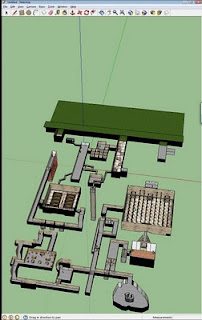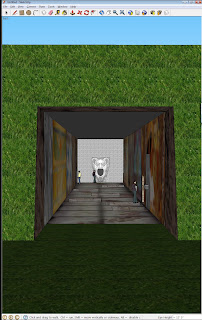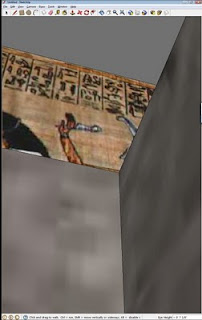The Ghinorians are a culture in the Majestic Wilderlands that believe they are the chosen people of Mitra, a goddess of justice and honor. One consequence is that slavery and later serfdom are not widely practiced in regions dominated by Ghinorian culture. The main reason is theology, the church of Mitra teaches that all Ghinorians stand equal in judgment before Mitra.
But like any pre-industrial society the Ghinorian Society is not egalitarian. Economic power is a pyramid with a few very rich and a lot of very poor. The economic collapse and the loss of the money economy after the fall of their empire only exacerbated the social divide.
In most campaigns I played the Ghinorians pretty much as bog standard Western Europeans complete with feudalism and manors. However I wanted to get away a little from that and go with a presentation that emphasized their view as being the chosen people of Mitra.
So I did a little digging and think I found an a nice twist that doesn't render things near incomprehensible. Which is always a danger when trying to come up with your own cultures. The twist is the use of sharecropping. Commonly known from the post civil war South it turns out that it been practiced throughout history. The basic gist of sharecropping is that the landowner provides the lands, maybe even the seed and stock. In exchange he gets a share of the crop. At times it is a good deal as the sharecropper has incentive to make the crop yield as hight as possible and a poor person can get into sharecropper a lot easier than trying to build a farm. Of course in any situation where the powerful and the weak have a relationship horrendous abuse can and will occur. Especially in situations were the rule of law is weak.
In lieu of serfdom, Ghinorian Feudalism will rely on sharecropping as it foundation. Throw in tenant farming I got something that different but understandable.
Ghinorian FeudalismThe hallmark of Ghinorian Culture is their belief that they are chosen people of Mitra. In the northern successor states Church of Mitra will accept anybody as Ghinorian who converts to the worship of Mitra. As a consequence Ghinorian law, and custom treats all Ghinorians (native or converted) as equal before Mitra. The presence of these beliefs in Ghinorians lands contributes to the near absence of slavery, serfdom, and other various forms of unfree status for the lowest social classes
The collapse of the Ghinorian Empire also caused a collapse of the money economy. Settlements and regions focused more on self-sufficiency than specialized trade. The revival of the old imperial ideals in the Restored Ghinorian Empire centered on Kalnala (Tarantis) or the Dragon Empire of Caelam (City-State) only halted the trend. When these two empires collapsed the old money economy disappeared.
Among the Ghinorians, noble titles were attached to offices. During the days of the empire, these offices were funded by the Imperial Princes from the taxes collected and the coin earned from the Imperial Estates. With the lack of hard coinage the successor states had to turn to alternative arrangements. The offices were granted to large landowners along with a benefice consisting of several Imperial Estates. Contracts with the tenants where changed from money based to various tenant farming (if they own their own tools) or sharecropping arrangements based on the payment of a portion of the harvest.
While never reduced to slavery or serfdom the combined economic and legal power of the landowner considerably reduced the social standing and power of the peasantry. The worst cases found themselves in perpetual debt to the landowner. The trend for several hundred years saw individual farms consolidated into manorial villages so that the cost of tools, and livestock could be easily shared.
Manorial Villages saw a bailiff appointed to manage the landowner's interest. The villagers elected a Reeve (with the landowner's approval) to manage the day to day tasks. The Reeve in consultation with the bailiff appointed the village officers such as the Beadle, Hayward, and the Woodward. In regions that suffered from banditry, frontier marches, or attacks by monsters the appointed bailiff would be a trained knight. For landowever that owned only one estate would live in the village manorhouse himself.
A peasant's social status in Ghinorian villages was determined by land ownership. Freeman owned their land and tools outright. However many freeman paid some rent to use the village oxen and plot to benefit from the economy of scale. Crafters performed a trade like Tanning, Carpentry, Smithing, etc. Much of their business was conducted via barter and for a share of the crop.
Tenant Farmers did not own their land but owned their tools and stock. Like freeman they would often pay to use the village oxen and plow rather than maintain their own. The land they worked was rented from the landowner on long term fixed rent contracts. These contracts were
transferable to their heirs. Poor Harvests often saw them going into debt.
The lowest rung was occupied by Sharecroppers. They neither owned their tools or land. They worked for a fixed percentage of the crop (usually 1/3) and under the direct supervision of the village Baliff and Reeve. They often hire themselves out to Freemen and Tenant Farmers.
The land surrounding a Ghinorian village is organized in several ways. First is divided into broad agricultural use. Woodlot, pasturage, cropland, and finally wasteland. Woodlot is strictly managed by the woodward to preserve the village wood supply as well as supply of wild herbs, and a place for hogs to forage in the summer and fall. Pasturage is used for the grazing of livestock particularly goats and sheep. Cropland is divided into three great fields. One is left
fallow, another is planted with a cover crop, and the last with the village's main crop (wheat, barley, rye, etc). This three field rotation ensue that that the soil is not exhausted by the intensive farming.
Land Ownership is handled by strips that are measured in a amount of land that a ox team can plow in a day. While the fields are worked communally, the strip boundaries are marked so that each farmer's share of the harvest can be measured. The landowner's strips are either rented out to tenant farmer or sharecropped.
The nobles are those that held both land and a position of authority in a Ghinorian Realm. During the Empire military and legal authority were carefully separated. But as the money economy declined, the Princes began appointing wealthy landowner to both positions. This combined the power of both into one person. Along with the offices came Imperial Estates. As the centuries wore one many of these offices were viewed as hereditary and the current form of nobility achieved it's final form.
The office of Prince existed since earliest days of the Ghinorian. Originally a tribal leader, this was transformed into the office of the Imperial Prince when the Ghinorian Empire was formed. Below a prince is the Duke, originally a military officer equivalent to a general. The office of Duke was combined with the that of the provincial judge. Below a Duke is the Count originally a subordinate officer in charge of a army's wing. To the office of count was attached the power of a district judge. As the revived empires collapsed the office of Count disappeared in many Ghinorian lands. Below a Count is the Baron. Barons were originally legates in charge of specific units in the Ghinorian army. To their office was attached the judgeship of a settlement.
Ghinorian Knights originated as cavalry in the Ghinorian Army. The cavalry always attracted the upper social level and the position became synonymous with high status. With the rise of armored cavalry on the battlefield their position became part of the nobility.
For roleplaying purposes the effect on many settlements is similar to the 19th and 20th century company towns. In this case the company being the landowner who owns much of the surrounding land.
 You learn something new everyday. Yesterday I stumbled across this post about Linen Armor at
You learn something new everyday. Yesterday I stumbled across this post about Linen Armor at 

























